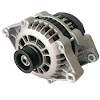Chain Reaction
It may be defined as a fission reaction in which the neutrons from a previous step continue to propagate and repeat the reaction.
We know that in nuclear fission heavy nucleus (Uranium) split into two or more similar nuclei when it bombarded by slow moving neutrons. This causes emission of neutrons (fission neutrons) with the release of huge amount of energy. These fission neutrons cause fission. If this process is repeated, then in a short time huge amount of energy will be released which may cause explosion. This is know explosive chain reaction actually in a reactor, controlled chain reaction is taking place which can be done by systematically removing fission neutrons from the reaction.
Example when U235 nucleus hit by a neutron the reaction is as follows
U235 + n1 La148 + Br85 + 3 Neutrons
Each of the three neutrons produced in this reaction strikes another U235 nucleus, which further causes production of nine subsequent reactions. These nine reactions in turn further give rise to twenty seven reactions and so on. The process of reaction by multiplication in threes at each fission is shows in fig
Use of Moderator:
A material in the reaction core which moderator or reduce the energy and speed of fast moving neutrons without capturing them, and there by controlling the chain reaction is know as “Moderator”.
We know that during fission process, the neutrons at a very high velocity of about 1.5x107 m/s, with very large kinetic energy are produced. But for more effective and efficient use in nuclear reactor, it is desirable to slow down the speeds of neutrons to 2.2x103 m/s, such neutrons are called slow or thermal neutrons. When the natural uranium bombarded by these slow neutrons, the chain reaction can be maintained this slow down of neutron speed, can be accomplished with the help of “Moderator” fig
The moderator should have low neutron absorption property. Heavy water and Graphite are generally used an moderator. The other rarely used moderator materials are hydrogen, Deuterium, Helium, Lithium, Beryllium, Boron, Carbon and Nitrogen.










0 Comments